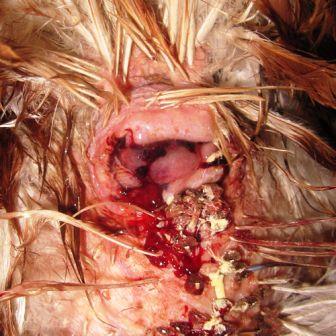About flock that will serve as food I often do not think it is worth the costly fees of veterinarians. I understand that people with pet chickens or rabbits with a cold go to the vet. Or that you do so to prevent contamination of your herd.
An animal that is injured you take care of just like a human. Is it too seriously injured, then you can still slaughter it. You hardly can go paying € 50 consultation fee for 1 kg of chicken that charges € 5.
To nurse larger animals you need extra hands, to hold them. Or tie them (horses, hoof care ...). Use belts instead of cutting ropes.
The first time I went shearing sheep (with hand shears, a type that is now used for boxwood) I needed a lot eosin both for my own blisters as for the cut wounds in the sheep skin.
 A turkey who was mauled by a dog once I had only found a few days later. The wounds were full of maggots. There were too much and too deep wounds to clean them. Hopeless. I had to finish and bury her.
A turkey who was mauled by a dog once I had only found a few days later. The wounds were full of maggots. There were too much and too deep wounds to clean them. Hopeless. I had to finish and bury her.
A young goose whose pens were cut at the wrong moment got cut blood and fluid between the remaining stumps. Where fly eagerly laid their eggs. Additional wounds occurred by moisture and sanding of the stumps. Which were crawling with maggots. The largest gatherings I have wiped away as much as possible with a clean paint brush. The remaining -I estimate 1.000 maggots- I plucked as much as possible with tweezers. 3 hours of work. The maggots went in a small bucket of water. Those were for the fish. Chickens also tuck it. If you have domesticated chickens, you can even get help of them. They are much faster, and watch much better than we do.
In some holes in the wing (up to 10 mm deep) were still worms, which I could not catch. As the worms eat decaying flesh, and the stench was anything but pleasant, I let those sit overnight. (Also for people maggots are used to clean dead tissue from wounds.) The bare, dirty and bloody parts of the goose I then washed with soapy water and some vinegar as thoroughly as possible.
Since the worms incredibly quickly moved through the damp feathers and wounds, I then dried all those parts and the wet feathers blowing with a hairdryer. The goose felt clearly delicious with this treatment. And by the warm drought the smallest worms (and I suspect the eggs too) also were finished. Because of the predicted rain I also kept her in a dry area.
The next day I repeated all this. The dry patches were clean, and free of maggots. The holes in the wing not yet. The 'some' worms that I expected there were at least about 50. I have the deeper wounds dripped full several times with diluted disinfecting detol. This also drove most worms (partially) out. I have repeated this a three times a day: reviewed and catching. (The flies kept coming.) And every time I disinfected and dried with the hair dryer. It turned out to be fine for the goose.
For disinfecting stables I use diluted bleach. In forms of diarrhea in chickens we did put a few drops in the drinking water.
(In the absence of other disinfection stuff I have, when my little finger had been between a belt sander, also used it at self. It picks up but disinfects.)
